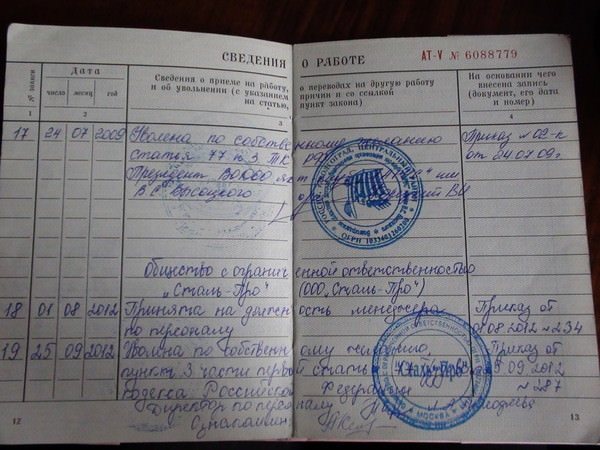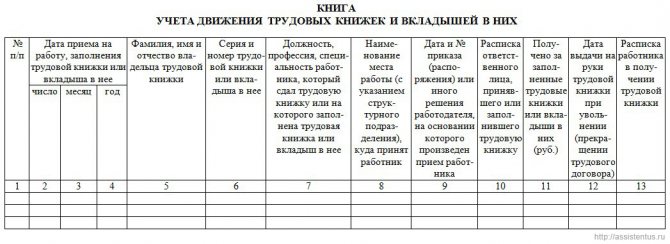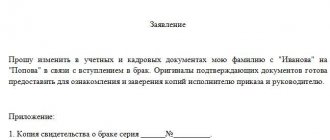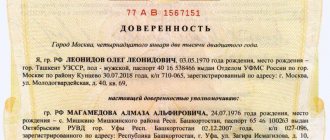The Ministry of Labor and Social Protection of the Russian Federation prepared and put up for public hearing a draft order “On approval of the form, procedure for maintaining and storing labor books.” This order abolishes certain requirements in labor legislation for maintaining paper work books. The draft was published on the federal portal of regulatory legal acts on January 11, 2021.
We all know that the transition to electronic work books began on January 1, 2021, while the paper form of the work book is not canceled. According to the Pension Fund of the Russian Federation, out of 58.1 million insured persons, more than half chose to maintain a work record book on paper, and only 5.1 million Russians chose to maintain information about their work activities in electronic form.
Many citizens ask to leave the paper work record book that is already familiar to everyone. Employers, as before, need careful, impeccable and correct entry of records.
Legislative acts
Legal regulation of issues related to the document described, the rules for its maintenance, storage and other issues is carried out in several legislative acts:
- Labor Code of the Russian Federation.
- Decree of the Government of the Russian Federation No. 225 “On work books” (2003).
- Instructions for filling out work books (2003).
The Labor Code determines the status of the document in question, the responsibility for its execution is assigned to the employer, and the information entered in the book is listed.
The following two documents specify the issues of maintenance, accounting, storage and others related to this document.

The legislative framework
The rules approved by Government Decree No. 225 dated April 16, 2003 explain and regulate the administration. They spell out general issues of the procedure for maintaining, storing, making changes, corrections, and issuing, including duplicate books.
The rules consist of eight sections:
- General provisions.
- Maintaining documents.
- Making changes and corrections. Duplicate work book.
- Issue upon dismissal.
- Insert.
- Accounting and storage.
- Responsibility for maintaining procedures.
- Production of forms and provision of them to employers.
The instructions approved by the Ministry of Labor on the procedure for filling out work books and inserts for them contain relevant instructions for each of the areas. The procedure for making entries in work books is established by Resolution of the Ministry of Labor dated October 10, 2003 No. 69, which contains seven sections.
General provisions
Entries should be made carefully, in black, blue or purple ink, without any abbreviations. For example, the surname, first name and patronymic must be written in full; writing a surname with initials is not allowed. Arabic numerals are used. Columns are filled in capital letters. There is only one exception: when the employee signs on the title page, he is allowed to write his full name in block letters to avoid confusion and possible questions.
Filling out employee information
When filling out the book for the first time, indicate the following information on the title page:
- surname, name, patronymic of the employee;
- full date of birth;
- information about the education received;
- specialist diploma (if available).
This is what a sample of filling out the title page of a work book looks like:

The section contains information on the basis of which documents and in what order information about the owner is entered, including when changes are made to personal data.
For example, changes in records of last name, first name and patronymic are made on the basis of a passport or other documents and with reference to their number and date. These changes are made on the first page (title page). The previous surname, first name or patronymic is crossed out with one line and new data is written down. Links to the relevant documents are made on the inside cover and certified by the signature of the employer or a specially authorized person and the seal of the organization (or the seal of the personnel service).
Filling out job information
In accordance with Article 66 of the Labor Code of the Russian Federation), the employer is obliged to keep records of work experience for each employee who has worked for more than five days, and when the work is the main one. The section describes the procedure and sequence for making entries about the function performed by the employee, about the assignment of ranks, classes or ranks.
For example, in column 3 of the “Work Information” section, the full name of the organization is indicated as a heading, as well as the abbreviated name of the organization (if available).
In the third column, a record is made of acceptance or appointment to a structural unit of the organization, indicating the specific name, position, specialty, profession, indicating qualifications, and in column 4 the date and number of the order (instruction) or other decision of the employer according to which the person was hired is entered. . Records of the name of a position, specialty, profession indicating qualifications are made, as a rule, in accordance with the organization’s staffing table.
If, in accordance with Federal laws, the performance of work in certain positions, specialties or professions is associated with the provision of benefits or the presence of restrictions, then the names of these positions, specialties or professions and the qualification requirements for them must correspond to the names and requirements provided for in the relevant qualification directories.
When applying for a job, the book is filled out in the following order:
- Column 1 - enter the serial number of the current record;
- Column 2 - the date from which the employee was hired;
- 3 columns - full and abbreviated name of the employing organization, exact name of the position according to the staffing table, qualifications;
- 4 columns - number and date of the order for enrollment.
Filling out information about the award
According to the instructions for filling out work books, this section contains information about the titles, diplomas, certificates and other awards assigned to the employee, provided for by the legislation of the Russian Federation and the internal regulations of the organization. The following are required to be entered:
- presentation of state awards;
- awarding diplomas, certificates, insignia;
- incentives prescribed in the Labor Code of the Russian Federation.
A corresponding entry indicating by whom, when and for what merits the employee was awarded is made in column 3 of the “Information on awards” section. The details of the base document are indicated in a special field.
Another type of award is “Gratitude”. It is entered into the document only if it is formalized by an appropriate order in the organization.
Filling out information about dismissal
Due to its importance and volume, the section contains not only detailed and specific explanations and rules for making entries about the reasons for termination of the owner’s contract. To do this, specific instructions are given for filling out work books 2021 with comments and examples. When a contract is terminated on the grounds provided for in Article 77 of the Labor Code of the Russian Federation (except for cases of termination of the contract at the initiative of the employer and due to circumstances beyond the control of the parties), a record of dismissal (termination of the employment contract) is made in the form with reference to the paragraph of this article. For example: “Dismissed by agreement of the parties, paragraph 1 of Article 77 of the Labor Code of the Russian Federation” or “Dismissed at his own request, paragraph 3 of Article 77 of the Labor Code of the Russian Federation.”
Features of filling out information about dismissal (termination of contract) and hiring (appointment) in connection with the transfer of an employee to another permanent job with another employer (to another organization) or his transfer to an elective job (position)
When an employee moves from one position to another, a corresponding note is made in the work book. It is important to note that the transfer is recognized as legal only if there is the consent of the employee himself.
There are two types of transfers from one position to another:
- internal - the employer remains the same;
- external - the contract with the current employer is terminated and a new employment contract is concluded.
Also, the transfer can be permanent or temporary - when replacing a temporarily absent employee. In this case, in the third column:
- when transferring externally, indicate the date and number of the order of dismissal from one organization (full name), the date and number of the order of enrollment in another organization (full name). Indication of positions is necessary in both cases;
- when transferring internally, it is written as follows: “transferred to position” indicating it, the name of the department, if necessary.
Features of filling out a duplicate
In fact, the provisions of this section are divided into two subparagraphs: filling out a duplicate with the previous employer and filling out a duplicate if the employee worked for another employer before joining the organization.
The guidelines contain the form of the receipt and expenditure book for recording the forms of the work book and the inserts in it and the form of the book of accounting for the movement of work books and the inserts in them.
To whom must this document be issued?
Each employee, provided he works for more than 5 days with the employer, must have a work book. Condition: the employee must be hired for the main job. Exception: the employer is an individual. person and is not an entrepreneur.
For a citizen whose job is a part-time job, therefore, this document is drawn up for the main job.
This document must be completed at the expense of the organization in the following cases:
- initial hiring;
- loss or damage;
Part-time records
Entries about part-time work are entered into the form by an employee of the HR department at the permanent place of work. Based on information from the part-time job. Recording a part-time job is optional and is made at the request of the owner of the work book.
The procedure for making a record of part-time employment consists of the following numbered columns:
- Record number in order.
- Date of admission to the headquarters of the enterprise part-time.
- Indication of position, specialization, etc.
- Indication of the document that became the basis for the entry (employment contract, order, etc.).
Rules of conduct
The Resolution on Work Books regulates in detail the nuances associated with maintaining this document for each employee.
It is established that the following information must be entered in the book:
- personal data;
- work performed, including transfers to another location;
- layoffs;
- awards;
When applying for a job, a citizen presents, including the labor document. In case of its absence, a new book is started, the first page of which is personal data, filled out on the basis of personal documents, education and qualifications.
Any entry can be made only on the basis of an order or order, and is recorded in strict accordance with its text. The numbering must be continuous, that is, from number “1”, and so on (in each section).
A record of termination of work for any reason must strictly follow the wording of the Labor Code of the Russian Federation (part, clause, article).
The section on incentives contains records of awards, both state and those made by the employing organization itself (except for incentives on a regular basis, in accordance with the regulations of the organization itself).
In cases of loss (loss, theft, has become unusable, etc.), the employee, upon his application, is issued a duplicate of the book. It includes information about:
- general work experience;
- continuous work experience;
- about your last place of work (including awards);
Special situations
Often, an employee of the HR department is faced with the question of how it is necessary to reflect data on the non-inclusion of any period in the continuous work experience. This often happens when a citizen of the Russian Federation is assigned correctional labor. In this case, a corresponding entry about correctional work is entered into the work book. It is made in the same way as a record of ordinary work activity (indicating the serial number of the record, date and name of the document that is the basis for making the record).
Special situations also include assigning a new rank, class, category to an employee, or obtaining a new profession. The corresponding marks are made in the information section about work according to the rules of the Labor Code of Russia.
If, during the course of an employee’s work, the company is renamed, information about this fact must also be reflected in the work book. This point is considered very important, since after the organization is renamed, its seal changes, and when an employee is dismissed, a completely different stamp will be given. In the absence of a record of a change in the name of the organization, the Pension Fund will not count the time spent working at this enterprise in the total length of service. The same applies to the renaming of the position held by the employee and to changes in the staffing table.
Record of admission and dismissal
The third section, labor, is intended for records of work. It is in a tabular form with graphs.
In order to make an entry, first enter the name of the organization (institution). It is not numbered. The name must completely coincide with the authorized name and contain an indication of the form of the organization in accordance with the Civil Code (for example, Closed Joint Stock Company). A stamp is allowed (if available).
Then enter:
- serial number of the record;
- date of admission (Arabic numerals);
- the entry itself indicating the position, profession (as provided for in the staffing table);
- date and number of the employment order;
Example of an appointment record:
"Open Joint Stock Company "Vesna" (LLC "Vesna") Admitted to the technical department for the position of energy engineer."
When making an entry about dismissal, they also enter the entry number, the date of dismissal (according to the order of the organization), and the entry itself in strict accordance with the provisions of the Labor Code of the Russian Federation. Then the signature of the person authorized to conduct personnel records, certified by a seal, is affixed, as well as the signature of the employee himself.

Rules for filling out the register
In the work record book, 13 columns must be filled out, each of which has its own purpose:
- Column 1 records the serial number of the insert or work book (without division);
- in columns 2 to 4, in Arabic numerals, the date (day/month/year) of the citizen’s employment, which appears in the appointment order, is recorded;
- column 5 – last name, first name and patronymic of the owner of the work book/insert, without abbreviations;
- column 6 – serial number of the document (insert or work book). For forms published in 1938-1973, book numbers are not provided; a dash is entered in the column. In documents issued since 1974, and in the most recent ones - 2003, a two-digit letter series (AT, TK or VK) and a seven-digit number are indicated;
- column 7 – labor function of the hired employee or his position, fixed in the staffing table;
- column 8 – name of the department or unit where the employee is hired (according to the staffing table);
- column 9 – calendar date and registration number of the employment order;
- column 10 – signature in the acceptance of the booklet/insert made by the responsible employee;
- column 11 – reflects the amount paid by the hired citizen for providing him with a work book form/insert;
- Columns 12-13 are filled in upon dismissal. In column 12 the number of return of the work book is entered, and in column 13 the former employee is required to sign for receipt of the document.
You need to know: when issuing a work book insert to an employee, the entry is made in two lines, with a separate indication of each document. If the hired employee already has an insert sewn into the work book, then only the original document is recorded in the journal.
Important: an organization can issue a local act according to which the cost of a work book will not be charged to newly registered employees.

FILES
In some situations, columns 12-13 contain information about when a registered notification is sent to a former employee by post about the need to obtain an employment document. This happens if the resigned employee does not show a desire to pick up his work book, or cannot do this for other reasons.
If, after a postal invitation, a citizen refuses to personally receive a work book, the form is sent to him by mail.
Bug fixes
If it is discovered that there are errors or inaccuracies in the records, they must be corrected in the following order:
- Assign a serial number to the entry.
- Enter the date the entry was declared invalid (in Arabic numerals).
- Make a note about the invalidity of entry No. such and such.
- Write the correct wording.
- Indicate the document on the basis of which the correct information is entered.
An error on the personal information page is corrected by crossing it out with a single horizontal line and placing the correct entry directly above the incorrect entry. At the same time, on the blank side of the cover they make the inscription: “Corrected to “....” believe” and is certified by a signature.
How to make changes to a work book
Naturally, no one is immune from mistakes, especially considering that the labor form is filled out manually.
If an error is detected when filling out a new book (from scratch), corrections are not allowed. The book is simply destroyed, and at the same time an act is drawn up stating that the document is destroyed.
But if an error is discovered during subsequent fillings, then the only way to correct it is to go to court. This is done so that a decision is made that the book belongs to this particular person. This is done when there are inaccuracies in the recording of the employee’s full name or other personal data. Based on this resolution, the following entry in the book is created.
Part-time work and entry
If a citizen considers it necessary to make a record of his additional work, he contacts the employer for whom he is the main employee with a document confirming his part-time job (employment contract, copy of the employment order).
The procedure for making an entry by the main employer includes:
- the employee's application;
- providing a document confirming additional work;
- issuing an order for the organization to enter such information into the labor report;
- making and verifying entries;
In case of dismissal of a part-time employee, the entry is made in the same way as the employment entry (by the main employer).
Innovations in the rules for filling out an employee’s work book
The changes affected certain issues of filling out an employee’s work book. We will consider each case in more detail below.
Remote employee
According to the updated rules for filling out a work report, it is permissible to enter information about the work activities of an employee working remotely. For this purpose, an employee working remotely is required to provide the employer with a work book. In this case, it is permissible to send the work report by registered mail with acknowledgment of receipt.
Stamps and seals acceptable in labor
According to the current rules for filling out a work report, entries in it can only be made by hand, using black, blue or purple ink. Starting from September 1, 2021, it will be allowed to make entries in an employee’s work record using “technical means by transferring dyes or in the form of a stamp (seal).”
Deadlines for making entries in the labor record
The innovations will also affect the timing of making entries in the employee’s work book. In case of hiring, transfer to another job, qualification, upon presentation of an award, it will be necessary to make an appropriate entry no later than 5 working days .
The need to certify the dismissal record
If an employee is dismissed, information about this is entered into the work book on the day the employment contract is terminated. According to the innovations, in the event of termination of an employment contract with an employee, the dismissal record is certified by the signature exclusively of the employer or his representative, who is entrusted with the responsibility for filling out work books. A seal is required if it is available, but the signature of the dismissed employee will not be required.
Innovations in the design of the insert for the labor document
At the time of issue of each new insert, a note about this is made in the work book itself by affixing a stamp with the inscription “Insert Issued”, as well as indicating the series and number of this insert.
Part-time work
In the case when an employee works part-time, an entry about this is made in the work book by the “main” employer on the basis of a document that confirms the employee’s part-time work ( Part 5 of Article 66 of the Labor Code of the Russian Federation ).
According to the provisions of order No. 320n, if necessary, such an entry can be made, even if the employee is not currently working part-time, but previously this was the case. To do this, the employee must contact the employer for whom he previously worked part-time.
Making entries about hiring, transfer and dismissal part-time can be entered into the labor record, both in chronological order and in “blocks”, i.e. simultaneously on hiring and dismissal based on the termination of the employment relationship.
Accounting for books at the enterprise
Work books are documents of strict accountability, and each manager must develop and follow a regime for recording and storing them.
To do this, the following must be established and maintained:
- Receipt and expense book for accounting forms;
- Labor movement accounting book.
One is drawn up by the accounting staff, and the second by the personnel officer or the person who is entrusted with the responsibilities of conducting personnel records in the organization by order.
At the request of the personnel officer, he is given employment forms and inserts. A report on the availability of forms must be prepared monthly. Damaged copies are destroyed on commission and a report is drawn up.
The movement record book reflects information about the books transferred from employees, newly issued books to employees, and notes are made about the books handed over upon dismissal. Both books must be bound and sealed, and numbered.
New in the work book form from 09/01/2021
The Ministry of Labor has updated the form of the work book and its insert. This is what they look like as of September 1, 2021:
There is now a note on the title page that a stamp must be affixed if available.
The work book now has more pages for information about the work and fewer for information about rewarding or encouraging the employee. And this is understandable: after all, in the electronic form of the work book (SZV-TD), data on awards is not provided at all.
Thus, information about work in the new form of the work book is allocated 14 spreads, and not 10, as before 09/01/2021. Similarly for the award data: there are now 7 spreads instead of 10.
The very contents of the form and insert of the work book remain the same.
Storage of work records
Work books are documents of strict accountability . Any organization must develop regulations on their storage and accounting. Responsibility for storage usually rests with the personnel officer or other person in charge of personnel records.
Books that are not received by citizens for any reason must be kept by the personnel officer for 2 years, then transferred to the organization’s archive (where they are stored for 50 years).
Insert design
If all blank pages of the work are completed, the subsequent information is entered on the insert form. It is sewn into the end of the document. And on the title page of the main book a stamp is placed indicating the issue of the insert, indicating its number and series. The cost of the insert is paid by the employee. The rules for filling out are the same as for the main labor document:
- The insert is filled out by the employer.
- The date is stamped on the title page.
- Up-to-date information concerning the worker is added.
- The entry is certified by the personal signature of the person completing it and a seal.
Responsibility for compliance with the procedure for maintaining work books
The employer is responsible for the correct execution and safety of this important document. The manager usually does not personally conduct personnel records, but hires an employee according to the staffing table, or assigns responsibilities for personnel work to one of the organization’s employees. For improper performance of official duties, penalties provided for by the Labor Code may be imposed.
Failure to comply with the procedure for maintaining work records is an administrative offense, for which a fine may be imposed on officials of the organization, and in case of repeated violation of the same norms of the Administrative Code, a measure of liability in the form of disqualification for up to three years.
Sections
The work book form consists of three sections:
- Employee data.
- Information about work activity.
- Awards and information about them.
Section No. 1 indicates personal data: full name, date of birth, information about the profession and level of education of the document owner. The title page must contain the signature of the owner and employee of the human resources department of the organization where the document was created.
Section No. 2 indicates the employee’s entire track record, complete information about the employee’s hiring and dismissal, and information about the employer’s company is also indicated. Entries in the form are made without abbreviations, dates are written exclusively in Arabic numerals. Each entry must have its own serial number. The entry from different employers ends with the seal of his company.
In section No. 3, all data on the awards that the employee was awarded is noted. This includes records of awards of honorary certificates and diplomas, state awards and other types of incentives that are provided for by the legislative acts of the Russian Federation.









